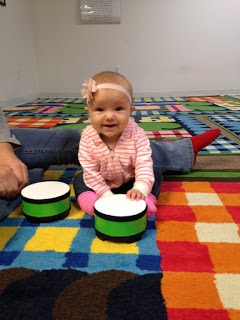Parenting Tip: Play with long & short sounds! Why? Musically, experiencing long & short sounds, movements, and visuals, fosters your child's developing sense of rhythm & articulation.
In Kindermusik, babies experience musical articulation while adults move them along to the music matching the articulation (like long & short). As toddlers, we will include the language of articulation as we model and label smooth and bumpy. Preschoolers will follow the contrasting articulation independently, following the musical cues alone. At the elementary level in Young Child, they will learn some musical terms, and begin to experiment with sounds on various instruments. Early literacy development involves the growth of key skills such as phonological awareness, auditory discrimination, active listening, and print awareness. Music naturally builds those skills (and more!) in children and makes them hungry for learning and reading! How? Play the Toast game! Do you hear long or short sounds, as the instruments play? What fun way can you find to help your child enjoy the final, short, POP of the toast? What goes well with toast? How about some TEA?!? Have fun with this fingerplay – modified for babies! How can you incorporate long & short sounds, and movements, into the game? Turn on the oven timer sound, from the Yum CD (or make the sounds, yourself, in a fun voice play game!), and make your feet 'tick, tick, tick' around the room. Don't forget to move baby upward when the timer goes 'Ding!' Want to learn more? On our blog: Read Four Ways Music Builds Early Literacy Skills Kindermusik 7-year Continuum: As babies, adults are helping baby notice long & short sounds (voices, sirens, basketballs tapping on the ground, woodpeckers pecking). As a toddler, children will begin to imitate those opposite sounds with her voice, and with instruments. As a preschooler, children will learn music terms for those sounds (long = legato; short = staccato). As a big kid, in Young Child class, children will use their experience with long/short to make sense of quarter note rhythms, and eighth note rhythms (which are shorter in sound than quarter notes).
In Kindermusik, babies experience musical articulation while adults move them along to the music matching the articulation (like long & short). As toddlers, we will include the language of articulation as we model and label smooth and bumpy. Preschoolers will follow the contrasting articulation independently, following the musical cues alone. At the elementary level in Young Child, they will learn some musical terms, and begin to experiment with sounds on various instruments. Early literacy development involves the growth of key skills such as phonological awareness, auditory discrimination, active listening, and print awareness. Music naturally builds those skills (and more!) in children and makes them hungry for learning and reading! How? Play the Toast game! Do you hear long or short sounds, as the instruments play? What fun way can you find to help your child enjoy the final, short, POP of the toast? What goes well with toast? How about some TEA?!? Have fun with this fingerplay – modified for babies! How can you incorporate long & short sounds, and movements, into the game? Turn on the oven timer sound, from the Yum CD (or make the sounds, yourself, in a fun voice play game!), and make your feet 'tick, tick, tick' around the room. Don't forget to move baby upward when the timer goes 'Ding!' Want to learn more? On our blog: Read Four Ways Music Builds Early Literacy Skills Kindermusik 7-year Continuum: As babies, adults are helping baby notice long & short sounds (voices, sirens, basketballs tapping on the ground, woodpeckers pecking). As a toddler, children will begin to imitate those opposite sounds with her voice, and with instruments. As a preschooler, children will learn music terms for those sounds (long = legato; short = staccato). As a big kid, in Young Child class, children will use their experience with long/short to make sense of quarter note rhythms, and eighth note rhythms (which are shorter in sound than quarter notes).



Leave a Reply